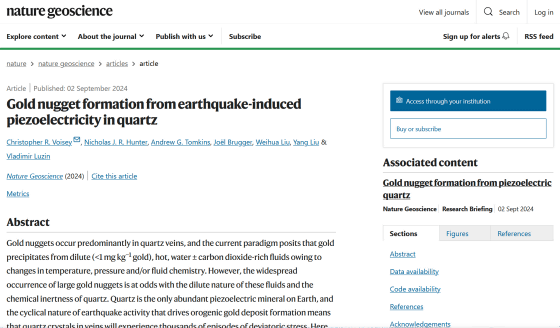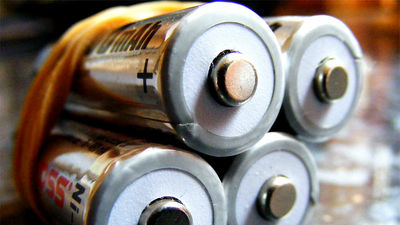Experiment reveals that 'gold nuggets' may be created by earthquakes

Gold nugget formation from earthquake-induced piezoelectricity in quartz | Nature Geoscience
https://www.nature.com/articles/s41561-024-01514-1

Electricity generated by earthquakes might be the secret behind giant gold nuggets - Scimex
https://www.scimex.org/newsfeed/electricity-generated-by-earthquakes-might-be-the-secret-behind-giant-gold-nuggets
Radical Theory Suggests Earthquakes Spark Gold Nuggets Into Existence : ScienceAlert
https://www.sciencealert.com/radical-theory-suggests-earthquakes-spark-gold-nuggets-into-existence
Earthquakes can trigger quartz forming into giant gold nuggets, study finds | Live Science
https://www.livescience.com/planet-earth/geology/earthquakes-can-trigger-quartz-into-forming-giant-gold-nuggets-study-finds
Quartz layers are key spots for gold mining, and quartz and gold precipitate from solution under fairly similar conditions. One theory about the mechanism by which gold nuggets form in quartz veins is that 'when hot water containing dissolved gold and silicon separated from magma flows through cracks in the crust, the silicon cools and crystallizes as quartz, and gold precipitates in the areas where it crystallizes.'
'While this theory is widely accepted, it does not fully explain the mechanism by which large gold nuggets form, particularly given the extremely low concentrations of gold in these fluids,' said Dr Chris Voysey , from the School of Earth, Atmospheric and Environmental Sciences at Monash University in Australia.
Gold is very difficult to dissolve in water as an element, so the gold concentration in hydrothermal fluids rarely exceeds one part per million. However, the gold nuggets found in quartz veins are actually concentrated in gold at a concentration several thousand times higher than in the original hydrothermal fluid. Therefore, the fact that 'gold in hydrothermal fluids precipitates with quartz' does not explain why gold is concentrated.
Based on the clues that 'gold veins are more common in areas with active mountain building and frequent earthquakes' and 'quartz is a piezoelectric mineral that generates an electric charge in response to geological stress such as earthquakes,' Voysey and his research team have come up with a new hypothesis: 'Gold nuggets may be created in quartz veins by earthquakes.'

Piezoelectricity is the property of generating an electric charge when stress is applied and deforming when a voltage is applied. The piezoelectricity of quartz is used in everyday items such as
Whenever an earthquake shakes the Earth's crust, the quartz generates an electric charge, but because quartz itself is highly insulating, the generated electric charge does not travel far. On the other hand, gold is a highly conductive material, so the electrochemical reaction of quartz caused by earthquakes could act as a catalyst and deposit gold in hydrothermal fluids. 'The frequency of seismic waves varies greatly depending on the magnitude and rock composition, but is between 1Hz and 20Hz or more. The waves distort the quartz, generating a voltage that can precipitate gold from nearby solutions,' Voysey said.
To test their hypothesis, the team submerged 12 quartz tiles cut from natural crystals in a solution of gold, then vibrated half of the tiles at 20 times per second for an hour while the other half remained submerged without being vibrated. The vibrations induced a voltage across the tiles of around 0.4 to 1.4 volts.
As a result of the experiment, it was found that micrometer-sized gold particles were formed on the vibrated tiles, but no gold was deposited on the non-vibrated tiles. In addition, in the vibration experiment using tiles with naturally scattered gold particles, it was found that further gold was deposited on the already existing particles as 'nuclei'. 'Once a certain amount of gold is deposited, its conductivity makes it more likely that more gold will be deposited because the gold will act as a catalyst for further reactions,' Voysey said.

by Géry Parent
Co-author Professor Andy Tomkins, from Monash University's School of Earth, Atmospheric and Environmental Sciences, said: 'The results were surprising - not only did the stressed quartz electrochemically deposit gold on its surface, but it also caused gold nanoparticles to form and accumulate on it. Surprisingly, the gold tended to deposit on existing particles rather than forming new particles.'
Because this experiment was simulated in a laboratory using concentrated gold solutions and long vibrations, it would take much longer for the gold to deposit in a real environment, where gold concentrations are low and earthquakes are rare. However, this is not so slow on a geological time scale, and the researchers say this provides a good explanation for the mechanism by which gold deposits and forms into gold nuggets.
Related Posts:
in Science, Posted by log1h_ik







